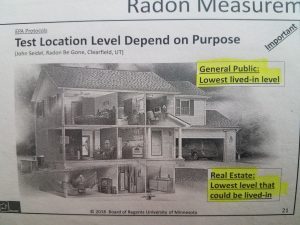We recently had the pleasure of attending a 16 hour class and certification program sponsored by the University of Minnesota and NRPP-AARST. A primary focus point of this continuing education class was the difference between radon testing protocols for real estate transactions vs. testing for the general public (aka a self-motivated home-dweller). As a result, the EPA provides the public with two guides : “EPA Citizens Guide” and “ EPA Home Buyer and Sellers Guide“. While the general principles of radon measurement and mitigation are similar throughout each document, there are several distinct differences. The EPA recognizes that real estate transactions are almost always on a timeline, and has incorporated these needs for buyers/sellers into their suggested measurement/testing protocols. We’ll explore a few of these below:
First, the test location (level) depends on the purpose of the test. The EPAs recommendations are different for the general public compared to a real estate transaction. We will use the same 2000sf home with a 1000sf finished basement for all of our hypothetical examples.
- Example 1: For the general public, the EPA recommends testing on the lowest lived-in level of the home. If a radon tester interviews the homeowner and discovers that they never go into the basement because of a hip-problem, testing would occur on the first level of the home.
- For a real-estate transaction, testing must occur on the lowest level of the home that could be used regularly. In this same home, the homeowner will not be able to tell you if the next tenants will be using the basement or not. As such, it is up to the licensed radon tester to determine if a finished basement is likely to be lived in. In our experience, the answer is almost always “yes” in this situation. As such, the testing would occur in the finished basement.
Secondly, the type and number of recommended tests vary depending on whether the testing is required for a real estate transaction, or is requested by a concerned homeowner.
- If testing for the general public, a single Short Term Test (ST) is advisable. If the results are under 4.0 pCi/L, further testing or mitigation is “not likely necessary”. If the results are between 4.0 pCi/L and 8.0 pCi/L, a Long Term Test (LT)is recommended. Licensed radon testers are obligated to make this recommendation, even though most homeowners do not want to invest the time (90+ days) or money involved with a LT test. The homeowner may choose to forego further testing and move right into mitigation, or substitute another ST test for the LT test. If the test results are over 8.0 pCi/L, a second ST test is recommended to confirm the results of the first test. The average of the two tests must be above 4.0pCi/L for a radon tester to recommend mitigation.
- Under no circumstance in this scenario should a radon tester recommend mitigation without performing two tests. Many homeowners, as mentioned above, forego the second test in favor of immediate mitigation.
- If testing for a real estate transaction, testers have three options: Sequential Testing, Simultaneous Testing, or Continuous Testing.
- Sequential testing is rarely used because of the time involved and likelihood of different results. In this scenario, a tester would deploy some sort of passive time-integrated device for about 2 days, and then immediately deploy another in the same location after the first test is complete. Because of the natural cycles (ups and downs) of radon levels in homes (especially diurnal cycles), there will likely be differences between the results. As such, an average of the two tests is presented to the buyer/seller.
- Simultaneous testing is similar, except both passive testing devices are placed side by side (no closer than 4 inches, but no greater than 5 inches apart) for the duration of the test. If both tests are above 4.0 pCi/L, mitigation is recommended. If both are below 4.0 pCi/L, mitigation is not recommended. If one is above 4.0 , while the other is below 4.0 pCi/L, further calculations are needed. If the upper test is grater than 2x the amount of the lower test, a new test must be conducted. If the higher test is less than 2x of the lower test, the average of the two tests should be averaged and presented to the buyer/seller.
- There is one caveat! Radon testers are required to calculate the RPD (relative percent difference) between the tests to ensure there are no un-expected anomolies affecting the test results. Only if that RPD is over 36% on the two tests that were under 4.0 pCi/L, are they valid. On the tests that both come back over 4.0 pCi/L, the RPD must be under 67% to be considered valid. These RPD calculations are conducted using a formula, with the results tracked in control charts for quality assurance.
- Continuous Radon Monitoring – This is the technique most-often used in Ohio real estate transactions. A continuous monitoring device takes measurements at least every hour, and must run for at least 48 hours. The first 4 hours of the test can be omitted to compensate for “ramp-up” (the time it takes the air inside the machine to be replaced with that of the home being tested). In this scenario, mitigation recommendations are simple. If the results are over 4.0 pCi/L, mitigation is recommended. If not, mitigation is not recommended. That said, a reading of 3.9 is not necessarily “safe”. There is no “safe” amount of radiation for humans to be exposed to.
As you can see, the EPA prescribes two entirely different protocols depending on the purpose of the test. It is the responsibility of the licensed tester to comply with these measurement protocols, as well as the associated documentation of such. For example, testers in Ohio are required to calibrate continuous monitors annually, cross-check their units with a known and recently calibrated unit once every six months, and log other procedural processess regularly. Testers using the passive devices must purchase and analyze blanks (testing devices never exposed to radon) and spikes (devices exposed to known levels of radon) regularly, perform at least 10% of their tests using duplicates, and keep the results in a control chart to ensure Quality Assurance.
For further information please call Akron Radon at 330-915-4999

